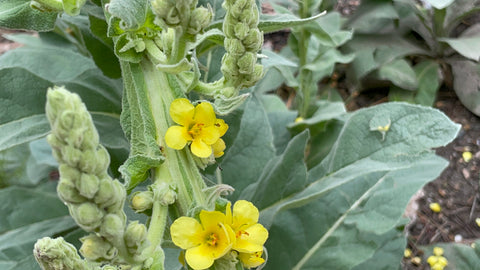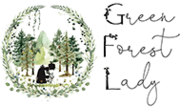Mullein, a most revered plant that has been used throughout time and whose uses are many, is by far one of my favorite herbs to study, harvest, utilize, and talk about. Mullein has been used for various health purposes since ancient times. Like most medicinal herbs, it has a list of names by which it has been called through the centuries. Names like candlewick plant, velvet plant, blanket leaf, Aaron’s rod, Jacob’s staff, torch plant, and our lady’s flannel to name a few.
Mullein grows well in gardens, but best in the wild in disturbed forest areas, beside streams, where floods or wildfires have been, or near roadsides where human disruption calls in Mullein to help fix the soil. Mullein belongs to the figwort (Scrophulariaceae) family and is an herbaceous biennial plant. The first year it produces a gorgeous basal rosette with silvery, thick, fuzzy, ovate leaves that can reach up to 12 to 18 inches in length and the second year produces a thick stalk with lovely, sunny yellow flowers that attract a beautiful array of native insects. After the release of its seeds (sometimes up to a thousand seeds per plant which can live in the soil for hundreds of years), the plant dies, and new cycle of Mullein begins.
In this article, we will explore the history of using mullein to improve health and how it is used today around the world. The scientific name of common mullein is Verbascum thapsus L. while Verbascum phoeniceum refers to the “hybrids mixed” variety which is also called Roman Candles. There are over 200 varieties of this amazing plant and many of them have been used to promote health for over 2000 years.

Mullein Benefits in Ancient Times
Mullein has a long and rich history of medicinal use that spans across cultures and continents. One of the earliest references to mullein comes from Dioscorides, a Greek physician and botanist who lived in the first century AD. He recommended mullein for lung and breathing disorders, such as asthma, bronchitis, and coughs. He also described how to prepare mullein tea, oil, and syrup from the leaves and flowers of the plant.
Mullein was also valued by the ancient Celts, who used it for healing wounds associated with varicose veins and soothing skin irritations. Mullein has even been used to treat tuberculosis.
Mullein Benefits in Medieval Times
Mullein was used for various health purposes throughout the Middle Ages. Mullein was used to treat everything from earaches, toothaches, hemorrhoids, diarrhea, kidney stones and evil spirits.
Mullein was also associated with magic and witchcraft in medieval times. Some people believed that mullein could ward off evil spirits and curses, while others thought that it could attract love and prosperity.
Mullein Benefits in Modern Times
Mullein is still widely used today for various health benefits, especially for respiratory conditions. It is recognized by a German scientific advisory board that evaluates herbal medicines, as a remedy for clearing the respiratory tract. Mullein contains anti-inflammatory compounds, such as flavonoids and iridoids, that can reduce inflammation in the lungs and airways. Mullein also has expectorant properties, meaning that it can help loosen and expel mucus from the lungs as well as being a respiratory tonic, demulcent which is helpful in soothing irritated mucosal membranes.
One commonly missed understanding about Verbascum thapsus is that the entire plant, from the stalk, flowers, leaves, and roots, has many different medicinal uses. Some that overlap, and others that are specific to the part(s) used.
Mullein is available in various forms, such as tea, capsules, extracts, tinctures, oils, syrups and lozenges, and fresh from the garden or wild harvested (responsibly) for use as a poultice. Mullein leaf tea is one of the most popular and simple but effective ways to consume the herb. It can be made by making an herbal infusion (boiling water then pouring over the herbs and covering with a lid to keep the plant’s essential oils contained and infusing for 20 minutes or longer.). Mullein tea can help relieve coughs, sore throats, bronchitis, asthma, allergies, tonsillitis, and other respiratory problems. Mullein leaf oil is another common product that can be applied externally or internally. Mullein oil can help soothe ear infections, skin infections, wounds, burns, insect bites and eczema.
Mullein flower oil has a high amount of resin, is a general emollient and is antibacterial which is ideal for soothing ear infections as it treats both the infection and relieves the pain. Mullein flowers are also a wonderful nervine remedy for children and can help bring on sleep and relaxation if the child is experiencing pain or discomfort. Mullein oil has also been taken orally to help with diarrhea and migraine headaches. A decoction or tincture of Mullein root can be taken as a urinary tonic or diuretic and is therefore very effective in helping urinary tract and kidney infections and helps to restore proper function of the bladder muscles when incontinence is occuring. All parts of Verbascum thapsus have been described by physio-medicalist Dr. William Cook as a wonderful lymphatic system remedy by having “peculiar and reliable power.” Herbalist Jim McDonald uses mullein as a remedy for the skeletal system where the science of this particular applied medicine is newly emerging.

Mullein is used not only in Western herbal medicine but also in other traditional systems of medicine around the world. Preparations of the mullein plant have been ingested via mullein oils, lozenges, capsules and teas, applied on skin as mullein salves and oils, and even smoked for acute respiratory conditions such as cough, croup, bronchitis, sore throat, hoarseness, and bronchial inflammation where a wet cough is indicated. The smoke rapidly infuses into the lungs and relaxes the bronchioles very quickly and effectively. However, use is not recommended for those who are actively experiencing an asthma attack.
A randomized, double-blind, controlled clinical trial in 2021 concluded that Verbascum Thapsus is effective in repairing episiotomy, which is a surgical incision, wounds. Mullein was used for the study as “the chemical structure of the Verbascum contains substances such as tannins, alkaloids, and saponins, polysaccharides, and flavonoids, each of which can be responsible for wound healing activities. The flavonoids and polysaccharides in this plant (Mullein) cause the proliferation of fibroblasts and connective tissue, which causes a significant effect of the Verbascum in the process of healing incisional and excisional wounds.”
For example:
- In China, mullein is used to treat tuberculosis, pneumonia, asthma, coughs, colds, flu, fever, sore throat, bronchitis and sinusitis.
- In India, mullein is used to treat asthma, bronchitis, coughs, colds, fever, sore throat, tonsillitis, earache, headache, toothache,, rheumatism, arthritis, gout, sciatica, neuralgia, epilepsy, hysteria, insomnia, impotence, infertility, menstrual disorders, urinary disorders, kidney stones, jaundice, liver problems, spleen problems, diarrhea, dysentery, hemorrhoids, worms, skin problems, wounds, burns, boils, ulcers, eczema, psoriasis, scabies, ringworm, and leprosy.
- In Mexico, mullein is used to treat asthma, bronchitis, coughs, colds, flu, fever, sore throat, tonsillitis, earache, headache, toothache, rheumatism, arthritis, gout, sciatica, neuralgia, epilepsy, hysteria, insomnia, impotence, infertility, menstrual disorders, urinary disorders, kidney stones, jaundice, liver problems, spleen problems, diarrhea, dysentery, hemorrhoids, worms, skin problems, wounds, burns, boils, ulcers, eczema, psoriasis, scabies, ringworm, and leprosy.
- In South America, mullein is used to treat asthma, bronchitis, coughs, colds, flu, fever, sore throat, tonsillitis, earache, headache, toothache, rheumatism, arthritis, gout, sciatica, neuralgia, epilepsy, hysteria, insomnia, impotence, infertility, menstrual disorders, urinary disorders, kidney stones, jaundice, liver problems, spleen problems, diarrhea, dysentery, hemorrhoids, worms, and skin problems.
Published studies and anecdotal evidence has demonstrated that Mullein is generally considered safe and well-tolerated with no reports of major side effects. Although contraindications to mullein have not been identified, it is important to remember that side effects during pregnancy, nursing and for young children have not been tested.
Because there are always risks of side effects for at least some of the population, it is worth mentioning some of the more common side effects reported from mullein:
- Skin rash: Harvesting fresh Mullein leaf can cause an itchy, allergic rash called contact dermatitis due to the fine hairs that give it its furry texture. However, because the leaves are strained from oil-based products, there should be no issue using mullein oil directly on your skin. Using a strainer with a cheesecloth or coffee filter lining to filter out the solids when making mullein tea is highly recommended to avoid any mouth and throat irritations.
- Medication interaction: Mullein may also interact with some medications; it is important to discuss drug interactions with your doctor or pharmacist before adding oral Mullein to your self-care regime.
Mullein is a natural remedy that has been used for centuries for various health purposes and one that is safe for the whole family. It is mild in taste, effective, and one that can easily be added to other herbal remedies. A large study in 2021 concluded the use of Mullein in traditional medicine as a healing plant related to various pathologies, most of them involving inflammatory processes, can be justified from a scientific point of view.
However, this conclusion is not a substitute for medical advice or treatment. If you have any health concerns or questions about using mullein, you should talk to your provider before taking it.
Discover the healthing skincare properties of mullein with the Green Forest Lady wildcrafted mullein salve.


